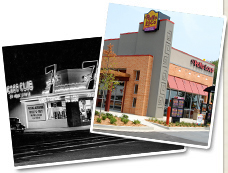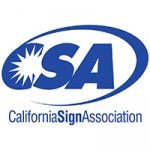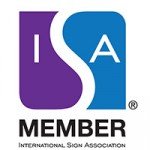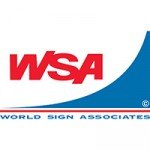
GLOSSARY
CLICK ON ANY LETTER FOR THE DEFINITION YOU NEED:
– A –
Acrylic: A type of plastic characterized by clarity, both transparent and opaque color ranges, and paintability used in sign making 2. Term generically used in the sign industry to describe all plastics. 3. Certain types of paint which have an acrylic resin as a vehicle.
ADA: The Americans with Disabilities Act. Federal standard governing building codes and accessibility. Title III governs signs.
Aluminum: A common light metal. Softer than steel, can be welded and formed.
Anchor: Various types of inserts used in concrete, brick, etc., to accept fastening hardware.
Architectural signage: A term coined in the 1960’s to identify visual communications and wayfinding information in a built environment.
Backlit sign: A sign consisting of a cabinet containing a light source and a translucent face.
Ballast: The component that regulates voltage to fluorescent tubes.
Bid package: Documents containing general conditions and specifications need for bidding. These documents typically describe design intent, materials, and installation.
Boom: 1. The crane on a sign truck. 2. The action of moving the crane, i.e. “boom up” or “boom down.”
Brand: A brand is “A name, term, symbol, or design, or a combination of them, which is intended to identify the goods or services of one seller or group of sellers, and to differentiate them from those of competitors.” i.e. The combination of the word “Courtney’s Cupcakes” with a unique cupcake logo would be a brand.
Brand Name: The pronounceable part of a brand is the brand name. i.e. The word “Whataburger” is a brand name. When put in combination with the brand mark “W”, the combination is called a brand.
Bronze: 1. an alloy of copper and tin used in casting and fabricating letters + plaques. 2. A moderate yellowish brown or greenish metallic color.
Brushed finish: Finish given to metal, or other similar material, either by hand or mechanically, that produces a glossy, frosted appearance.
Building Permit: A written document issued by the appropriate government authority, permitting the construction of a specific project in accordance with the drawings and specifications that the authority has approved.
Bull-nose: The end of a cabinet or sign panel that has either fully rounded or half-rounded ends.
Buyout: To purchase a sign or component from an outside source.
By others: This term indicates that the work to be performed is not on the sign contract.
Cabinet: The back and/or sides of a display.
Cantilever: A sign mounted from the end. Also called a flag or end mount.
Certificate of Occupancy:Document issued by the appropriate local governmental agency, stating that a building or property meets local standards for occupancy and is in accordance with the public health and building codes.
Change Order: Written document between and signed by the owner and the contractor authorizing a change in the work, or an adjustment in the contract sum or length of time. Architects and engineers may also sign a change order, but only if authorized (in writing) by the owner to do so.
Channel: 1. A partition rising from the face of a wall or sign, or a letter, designed to confine light, or to provide a shadowing effect. 2. Structural metal in the shape of a “C”.
Channel letter: A fabricated letter, consisting of metal sides and internal illumination. Can have either a metal or plastic face.
Cold Cathode: 1. Type of electrode used for most luminous tubes and fluorescent lamps. 2. Large diameter (20-25mm) cold cathode tubing. Some colors available at 20mm. White only at 25mm.
Computer Aided Design/Drafting (CAD): System used to generate and reproduce line drawings. The output can be used for design, sales, and manufacturing.
Conduit: Plastic or metal tubing used to encase electrical wiring.
Contractor: Licensed individual or company that agrees to perform the work as specified, with the appropriate labor, equipment, and materials.
Copy: The sum of all words on a sign.
Corrugated: Metal or plastic material that has a “washboard” appearance.
Countersink: To ream a hole with a taper, to accept a tapered screw or bolt, so that is flush with the tapered surface.
Crazing: A “spider-web” cracking of plastic. Usually caused by weathering or cleaning with strong solvents.
– D –
Day-night effect: The effect created by a letter or sign that has a transparent or semi-transparent face, such as solar Plexiglas, backed with a translucent, light diffusing material, such as white plastic, vinyl or paint, and lighted from within. The daytime color will change when lit at night, according to the color of the backing material.
Deck sign: Letters mounted on an L-shaped raceway, lighted from behind.
Decorative: For looks only, not structural.
Design-Build Construction: Arrangement wherein a contractor bids or negotiates to provide design and construction services for the entire project.
Design intent drawings: Drawings that show the size, profile, dimension and basic relationship of sign to it’s location. Part of the bid package.
Detail drawing: A section of a drawing that is enlarged to show more detail, or more specific callouts.
Direct illumination: Signs lighted from the outside with floods, spots, etc.
Directional: A display which shows guidance information.
Directory: A display which shows location information.
Display: Refers to all signage and graphics.
Double face (D/F): A display reading from two sides.
– E –
Electronic Message Center (EMC): A large format LED or LCD display, used for indoor and outdoor advertising. Can be either monochrome or color, and can often support moving images.
Elevation: View from ground level.
Expansion shield: A metal device, inserted into a hole, which expands inside the hole when a bolt or lag is driven.
Exposed neon: Luminous tubing open to the eye, uncovered.
Exterior: Outside.
Extrusion: Metal or plastic sign components which are shaped by forcing the material through a die in a molten state. It is then cut to length and assembled into the finished product, i.e. Extruded aluminum cabinets, extruded plastic letter track, etc.
– F –
Fabricate: To manufacture all, or part of, a sign or display from basic raw materials, or component parts.
Face: 1. The area of a sign or display having copy, graphics, etc. 2. The front of an object.
Fascia: The facing band which finished off a canopy or building projection.
Fiberglass: Glass in a fibrous form, used in making certain types of signs, figures, etc. It can be layered, or blown with a spray gun over a mold. Useful for making odd or complicated shapes, and can be illuminated from within.
Fiber optics: This procedure involves the use of glass or acrylic rods, with a lights source at one end, with the light traveling through the rods to appear at the other end.
First surface: The outside or exposed surface, i.e. painting the first surface of a sign face.
Flag mount: A sign mounted from the end. See Cantilever.
Flashing: 1. The material, usually galvanized sheet metal, used to weather proof the joint between two construction elements, such as a roof penetration, or certain wall mounts. 2. The action given to a sign by a flasher.
Fluorescent: 1. In the sign industry, this term is generally used to describe all straight or “U” shaped hot cathode lamps. However, it actually refers to any powder coated glass tubing. 2. A type of paint that glows under a blacklight.
Footing: The concrete base into which a sign support is set.
Formed: An acrylic background or individual letter that has been given dimension by heating and shaping with pressure, vacuum, or draping over a mold.
Frosted: A fine-grained, slightly roughened surface, as on metal or glass, produced by sand blasting, painting, or chemically etching.
– G –
Galvanized: Metal that has been chemically treated to resist rusting, but hot dipping in zinc.
Gauge: A standard of measurement, primarily for the thickness of metal, or size of wire.
General Contractor: Licensed individual or company with prime responsibility for the work.
Gloss: A highly reflective surface, i.e. A glossy paint finish.
Grade: ground level.
Grade 1 Braille: A Braille format that included only the letters of the alphabet, numbers, and some punctuation.
Grade 2 Braille: A Braille format that includes more characters, including contractions. A Braille proofreader must approve final artwork.
Ground mount: Sign with the bottom directly touching grade.
Gusset: A reinforcing device used to strengthen a framework or structure.
– H –
Halo: 1. Lighting something from behind, with the light source being contained within the perimeter of that object to create a halo effect.
Hang bar: A horizontal bar located at the top of a sign face, designed to carry the weight of the face, eliminated sag, and helping keep the face retained in high wind loads.
Hardware: Generally refers to the clips, nuts, bolts, screws, and other metal attaching devices used to install letters and signs on walls, etc.
High Intensity Discharge Lighting (HID): Lighting elements normally used for large area lighting such as parking lots, warehouses, etc. Adapted for use in large formed sign cabinets.
Housing: The component that encloses the end of a luminous tube when direct connection to the high voltage wires is not possible.
– I –
Identification sign: Refers to the main display for a business, which relates its product, service, or name.
Illumination: Refers to and includes all forms of lighting, direct and indirect.
Incandescent lamp: An electric lamp in which a filament, in a gas or vacuum, gives off light when electrically charged.
Isometric view: A drawing made with a 30-60 degree triangle, with the object shown at an angle.
– J –
J bolt: Long bolt with a “J” or “L” shape at one end, and threads at the other. Used primarily to install signs where direct burial of the support pipe is not required.
– K –
Kiosk: A small portable or permanent structure used for light retail sales, information, and phone booths, graphic displays, etc.
– L –
Lamp: 1. Incandescent or fluorescent light. 2. The action of installing lamps.
Landmark: 1. A sign or display that is so outstanding it stands apart from those around it. 2. A building or structure set aside for preservation.
Layout: 1. A drawing which shows the intended design of a sign, and the copy placement thereon. 2. A full size drawing of a sign. 3. A rough sketch of what the finished product will look like.
LCD (Liquid Crystal Display) sign: A type of changeable copy sign using an LCD panel as the sign face. LCD signs are often used in public spaces, and can have fine detail and moving images.
LED (Light Emitting Diode) sign: A type of changeable copy sign using a matrix of Light Emitting Diodes. Commonly used in large outdoor systems, where the viewer is at least 10′ away.
Lease: Signs provided to a customer at a pre-determined monthly rate.
Legibility: How well a sign character can be read at a given distance.
Lexan: A brand of high impact polycorbonate sheet.
Light Emitting Diode (LED): A semi-conducting crystal with two terminals, used in electronic displays, and as indicator lights, etc., on certain equipment.
Logo: That part of a brand or trademark that appears as a symbol, design, or distinctive letter.
Low boy: Type of trailer with a very low profile used to transfer tall signs.
– M –
Marquee: 1. V-shaped, semi V-shaped, or flat wall mounted signs, with changeable or permanent copy. 2. A generic term that applies to anspecialty sign cabinet. 
Mast: The vertical support for an arm mounted sign. 
Material Data Sheet (MDS):Published information concerning the dangers of, and precautions to be taken with certain chemicals, spray cans, solvents, cements, etc.
Mechanical drawing: A line drawing specifically tailored to the needs of manufacturing, often generated using CAD software.
Message center: An electronically or mechanically changeable copy display, those changes being made from a location other than at the display.
– N –
Neon: See Luminous tubing. Note: Only those tubes filled with neon should be designated as neon. All others should be refered to as luminous tubing.
No exposed fasteners: To position fasteners in such a way as to make them the least noticeable, or invisible, i.e. on the side of a cabinet, countersunk, countersunk and filled, etc.
Non illuminated: A sign or display that has no lighting, either direct or indirect.
Not to scale: A sketch or drawing that has no reference scale.
– O –
Occupational Safety and Health Administration (OSHA): Government agency which administers federal regulations regarding occupational safety and health concerns.
Off premise signage: Signs that are placed off the business property.
Opaque: Solid, not allowing light or images to pass through. Also refers to a coating or cover without letting the color or image below to show through.
Open channel: A sign component that has a back and sides, but no face.
Open channel letter: A letter constructed with back and sides, but no face. 
– P –
Pad: Concrete foundation which is level with or below grade.
Pantone Matching System (PMS): A system of matching and reference for ink and paper colors. Since these colors are difficult to match in paint, this system’s use is minimized in the sign industry.
Pegged off: A letter or graphic that is raised from the background surface by means of studs, cups, blocks, or other types of spacers.
Penetration: A hole drilled into a wall or sign to accept electrical wiring either through a housing or approved conduit.
Perforated metal: Refers to any number of types of perforated metals: perforated, flattened and expanded, perforated and expanded, or simply perforated, used as walkways, sunscreens, decorative coverings, etc. Also referred to as expanded metal and Perforated expanded metal.
Plot plan: A plan view of a particular business or area, showing streets, buildings, traffic flow, property lines, sign locations, etc. 
Point of purchase display: A sign or display used in close proximity to the actual retail product being sold.
Post and panel: Type of sign that is composed of a face supported by round or square supports, usually informational in nature, and generally mounted low to the ground, for good visibility.
Primary wiring: Electrical wiring from a breaker box to a ballast, transformer, or other electronic device.
Push through: Process of manufacturing sign faces by routing out the copy or graphics, and inserting a cut out thru the opening, so that is either raised from, or flush with the surface. 
Pylon: Generally refers to all large, free standing signs.
– R –
Raceway: A continuous metal box, containing all required electrical components, onto which illuminated signs, letters, or graphics are affixed prior to installation. This technique is used where numerous penetrations into a wall or sign face is not recommended.
Reface: To replace an old face with a new one, without changing the size or shape.
Reflective: Capable of reflecting exterior directed light, giving the appearance of being illuminated, such as reflective vinyl sheet.
Remote: 1. An electrical component, such as a switch or terminal, that is distant from the actual sign, i.e. an inside on/off switch. 2. A sign that is off the customer’s property. See Off-premise Signage.
Request for Information (RFI): Written request from a contractor to the owner or architect for clarification of the contract documents.
Request for Proposal (RFP): Written request to a contractor, architect, or subcontractor for an estimate or cost proposal.
Retainer: The component that holds a sign face in place, or acts as a cover for certain face-retaining hardware.
Retrofit: To replace the face of a sign with a different material than it was originally designed for.
Return: The sides of a channel letter.
Reveal: An indented detail on a sign.
Reverse channel letter: A letter that has a face and sides, but no back, often using halo illumination.
Roof sign: A sign that is installed above the line of the parapet or roof of a building.
Rotator: The mechanism used to continuously turn a sign.
– S –
Sandblasting: To remove, incise, or texture an area by means of pressurized sand.
Scale: 1. An instrument for measuring distances on a drawing, map, etc. 2. The proportion between two sets of dimensions, i.e. between a sign drawing and the finished product.
Schedule: A listing of certain components, such as paint colors, pipe sizes, etc. on an Architectural drawing.
Scope of work: A written description of all work to be done on a particular contract.
Second surface: The back or reverse side of a sign face.
Secondary wiring: Electrical wiring from the ballast or transformer to the luminous tube or lamp.
Section: Profile view of an object as if part of it were cut on a plane and removed. Also called a cut away view, or cross section.
Self Contained: Letters and signs which have all the necessary wiring, transformers, ballasts, etc. enclosed within.
Shop drawing: A mechanical drawing of the sign or display, used for manufacturing.
Sign Location Plan: Usually a site plan or floor plan indicating where signs will be placed or located.
Sign Message Schedule: An inventory or list indicating the quantities of signs and messages for each individual sign. Typically used as a contract document for final text and sign wording, and keyed to the sign location plan. Provides sign type, location, and message.
Single face: A sign having copy on only one face.
Site: Location of a structure or group of structures.
Soffit: The bottom or underside of an overhang, such as a canopy or marquee.
Spacer: A device used in mounting displays and letters which causes them to extend from the background.
Stanchion: An upright support, permanently mounted or portable.
Stroke: The horizontal or vertical bar of a letter.
Stucco finish: Roller, spray, or brush applied finish similar to a rough plaster wall.
Stud: 1. Protrusion on the back of a sign or letter to facilitate mounting. 2. Vertical support for a wall.
Subcontractor: Specialized contractor who is subordinate to the prime or main contractor.
Survey: 1. To take accurate measurements of an existing sign or building. 2. To investigate a location with the intent of determining types of signage required. 3. A map of a sign location.
– T –
Tactile signage: High contrast, raised or incised signage, generally intended for the visually impaired. This would normally include Braille copy.
Template: 1. A cut out pattern, usually of wood, metal, or plastic, used in the transfer of shapes to finished material for cutting or painting, and testing accuracy. 2. Pre punched metal or plastic device used as a guide for drawing circles, ovals, arcs, and shapes.
Texcote: See Stucco finish.
Time and Materials (T&M): Written agreement wherein payment is based on actual costs for labor, equipment, materials, and services rendered, in addition to overhead.
Time switch: A device used to turn a sign on and/or off at a preset time.
Time & Temperature unit: Electronic sign which provide the time and temperature.
Toggle bolt: Self opening bolt used for hollow wall installations.
Tombstone: An upright receptacle for fluorescent tubes.
Traffic count: The amount of vehicular or pedestrian traffic passing a certain point in a given length of time.
Transformer box: A galvanized sheet metal box that holds a luminous tube transformer.
Translucent: Diffuses light, so that objects beyond cannot be viewed, but visible light can pass through. (Example: frosted glass)
Transparent: Clear, so that object beyond can be seen.
Tube support: Glass, metal, ceramic, or plastic device used to support luminous tubing.
Typical: One that is the same or similar to others.
– U –
Underwriter’s Laboratories (UL): A nonprofit organization, operating in the public interest, that maintains safety standards in electrical equipment and appliances. Licensed use of it’s label requires close adherence to their specifications.
– V –
Value Engineering (VE): Process of analyzing the cost versus the value of alternative materials, equipment, and systems, usually in the interest of achieving the lowest total cost for a project.
Variance: A method by which a government body formally deviates from the terms of its sign or zoning ordinance. Typically, obtaining a variance for a sign requires the applicant to show that it would not be contrary to the public interest or that literal enforcement of the regulations would result in unnecessary and undue hardship (due to conditions unique to the property.
Vent: A louvered or screened aperture in a sign which allows heat to escape.
Vertical: Perpendicular to the plane of the horizon, i.e. upright.
Vertical reader: Copy that reads vertically, rather than horizontally. 
– W –
Weep hole: Holes drilled in the bottom of formed or fabricated letters and sign cabinets to allow water drainage.
Wireway: Tube or rod, or structure similar to a raceway that contains electrical wires only, and does not contain transformers or ballasts.
– X –
– Y –
Yoke: A cable or other device used to distribute weight and balance when used to lift large signs and steel lengths.
– Z –
Z clip: Z shaped metal or plastic clip used in to make various sign attachments.
Zone: Relating to the sign industry, a geographical area with specific limitations for signs.
Zoning: Restrictions of areas or regions of land within specific area based on permitted building size, character, and uses as established by governing urban authorities.
Zoning Permit: Document issued by a governing urban authority that permits land to be used for a specific purpose.


